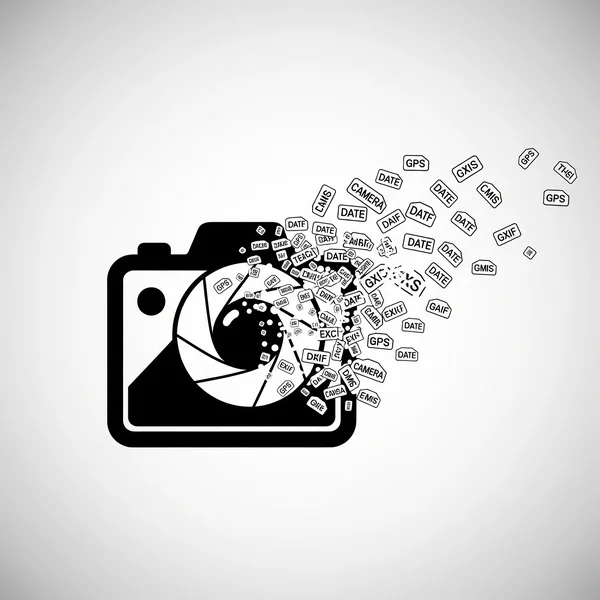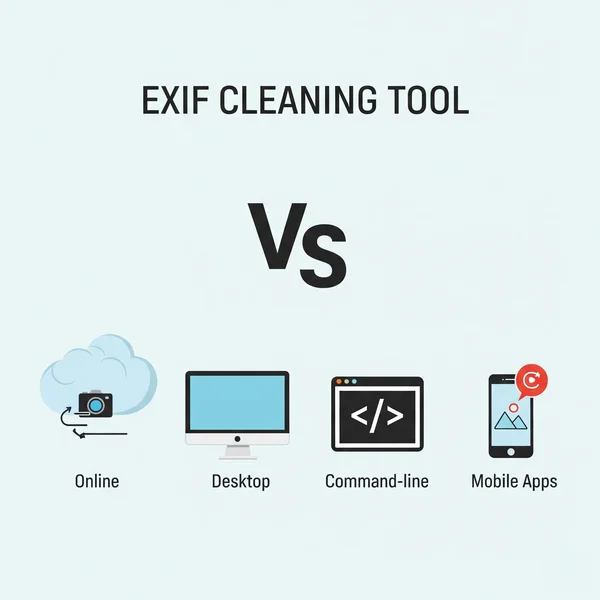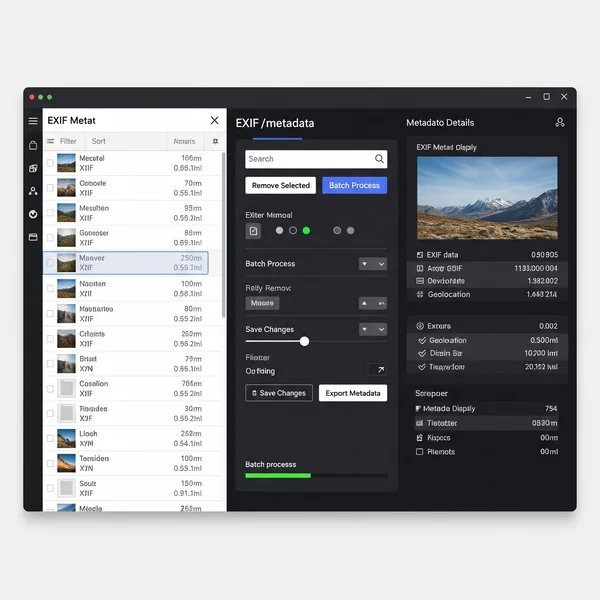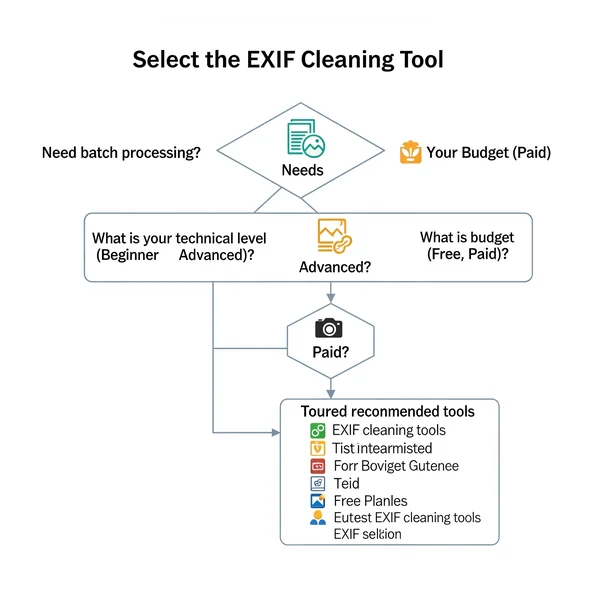Ultimate EXIF Cleaner Guide: Best Tools for Photo Privacy
In our digital age, every photo we take carries a hidden backpack of information known as EXIF data. This data can include everything from camera settings to the precise GPS location where the photo was snapped. While useful in some contexts, it can pose significant risks to your photo privacy and online security. That's where an EXIF cleaner comes in. But with so many options available, what tool removes image metadata effectively and suits your needs? This ultimate guide will help you navigate the world of metadata remover tools and find the best EXIF cleaner to protect your information. You can start exploring reliable options by checking out this user-friendly online EXIF remover.
What Exactly is an EXIF Cleaner and How Does It Work?
Before diving into specific tools, let's understand what an EXIF cleaner (often synonymous with a metadata remover) does and its basic mechanism. What is Exif cleaner?
Understanding EXIF Data: The Information Hiding in Your Photos
EXIF (Exchangeable Image File Format) data is automatically generated by digital cameras and smartphones. It includes technical details like aperture, shutter speed, ISO, camera model, lens type, and often, timestamps and geolocation data. While helpful for photographers to analyze their shots, this hidden information can be a privacy concern when images are shared online.
The Goal of an EXIF Cleaner: Protecting Your Photo Privacy
The primary goal of an EXIF cleaner is to enhance your photo privacy by removing or editing this embedded EXIF data. By stripping potentially sensitive information before sharing, you control what personal details are inadvertently broadcast with your images, contributing to your overall data protection.
Basic Mechanism: Identifying and Stripping EXIF Tags
Most EXIF cleaner tools work by reading the image file, identifying the various EXIF tags (data fields), and then allowing the user to either selectively remove certain tags or strip all EXIF data entirely. The cleaned image is then saved, ideally without altering the visual quality of the photo itself.

Key Features to Look For in a Metadata Remover Tool
When evaluating any image metadata tool, several key features distinguish a great tool from a mediocre one. Consider these aspects:
Supported File Formats (JPEG, PNG, RAW, etc.)
Ensure the tool supports the file formats you commonly use. While most handle JPEGs, support for PNG, TIFF, and various RAW formats (like CR2, NEF, ARW) is crucial for many photographers.
Batch Processing Capabilities for Efficiency
If you need to process multiple images, batch processing is a must-have feature. This allows you to apply the same metadata removal rules to hundreds or even thousands of photos at once, saving significant time.
Selective Metadata Removal
Sometimes you might want to remove GPS data but keep copyright information. A good metadata remover will offer selective removal, giving you granular control over which EXIF tags are stripped and which are preserved.
User Interface and Ease of Use
The user interface (UI) should be intuitive and easy to navigate, especially for non-technical users. A complicated UI can make even a powerful tool frustrating to use.
Security and Privacy Policy
For online EXIF cleaner services, carefully review their security measures and privacy policy. Ensure they don't store your images longer than necessary or misuse your data. Trust is paramount when uploading sensitive photos.
Speed and Performance
The tool should process images quickly, especially when dealing with large files or batches. Slow performance can disrupt your workflow.
Types of EXIF Cleaners: Pros and Cons Explored
EXIF cleaner tools come in various forms, each with its own set of advantages and disadvantages.

Online EXIF Cleaners: Convenience at Your Fingertips
Online EXIF cleaners are web-based tools that you access through your browser.
Pros: Accessibility, No Installation, Often Free for Basic Use
The biggest advantage is accessibility – you can use them from any device with an internet connection without installing software. Many offer free metadata remover options for basic use.
Cons: Internet Required, Upload/Download Time, Trust in Service
You need an active internet connection. Uploading and downloading large files can be time-consuming. Most importantly, you're entrusting your photos to a third-party service, so their security and privacy practices are critical.
Example Use Case: Quick Cleaning Before Social Media Upload
Online tools are excellent for quickly stripping metadata from a few photos before uploading them to social media. For instance, a platform like this secure online metadata remover offers a straightforward way to prepare images.
Desktop EXIF Removal Software: Power and Control
Desktop EXIF removal software is installed directly onto your computer.
Pros: Offline Use, Advanced Features, Potentially More Secure
These tools work offline, often provide more advanced features (like detailed tag editing and robust batch processing), and can feel more secure as your files don't leave your computer during processing.
Cons: Installation, May Cost Money, Learning Curve
You need to install and potentially update the software. Some advanced desktop tools are paid, and they might have a steeper learning curve compared to simpler online options.
Popular Desktop Options
Many reputable desktop options exist, ranging from free, open-source software to professional paid applications. Look for well-reviewed tools that match your operating system and feature requirements.

Command-Line Tools: For the Tech-Savvy User
Command-line tools operate via text commands in a terminal or command prompt. ExifTool by Phil Harvey is a very powerful and widely respected example.
Pros: Highly Customizable, Powerful, Scriptable
These tools offer unparalleled power and customization. They can read, write, and edit metadata in a vast array of file formats and are ideal for scripting automated workflows.
Cons: Steep Learning Curve, No GUI
They have a significant learning curve for non-technical users as they lack a graphical user interface (GUI). Is ExifTool difficult to use? For beginners, yes, it can be.
When to Consider Command-Line Options
Consider these if you need to perform complex, repetitive metadata tasks on large numbers of files and are comfortable working with command-line interfaces. They are a go-to for many IT professionals and advanced photographers.
Mobile Apps for EXIF Cleaning: On-the-Go Privacy
Mobile apps allow you to remove metadata directly from your smartphone.
Pros: Convenience for Smartphone Photographers
These are very convenient if you primarily take and share photos from your phone and want to ensure on-the-go privacy.
Cons: May Have Limited Features Compared to Desktop/Online
Mobile apps might offer fewer features than their desktop or comprehensive online counterparts, especially regarding batch processing or support for less common file formats.
Checking App Permissions and Privacy
Always scrutinize app permissions and privacy policies before installing any mobile EXIF cleaner. Ensure they aren't collecting more data than necessary.

Free vs. Paid Metadata Removers: Is a Free Tool Good Enough?
The choice between free and paid often comes down to features and support.
What to Expect from Free Metadata Removers
Many free metadata remover tools, especially online ones, are excellent for basic tasks like stripping all EXIF data from JPEGs. They can be perfectly adequate for casual users. What's a good free EXIF cleaner for beginners? Look for simple online tools with clear interfaces.
When a Paid Metadata Remover Might Be Worth It
Paid tools often offer more advanced features like selective tag removal, support for more file formats (including RAW), robust batch processing, customer support, and a more polished user interface. Professionals or those with specific needs often find paid options a worthwhile investment.
Evaluating Value Beyond Just Price
Consider the time saved through efficiency, the level of control offered, and the trustworthiness of the provider when evaluating value.
How to Choose the Best EXIF Cleaner for Your Needs
Selecting the best EXIF cleaner is a personal decision. Here’s a framework to help:

Assess Your Technical Skill Level
Are you comfortable with command-line interfaces, or do you prefer a simple drag-and-drop GUI? This will heavily influence whether you lean towards tools like ExifTool or user-friendly online/desktop apps.
Consider Your Typical Workflow and Volume of Images
Do you process one or two photos occasionally, or do you need to handle hundreds in a batch? Your volume will dictate the importance of batch processing capabilities.
Prioritize Your Must-Have Features
Make a list: Do you need RAW file support? Selective removal? Is offline access critical? This will help narrow down your options.
Read Reviews and Test Free Trials if Available
Look for reviews from trusted sources and other users. If a paid tool offers a free trial or a basic free version, test it to see if it meets your expectations before committing.
Your Path to Enhanced Photo Privacy: Selecting the Right EXIF Tool
Choosing the right EXIF cleaner is a crucial step in safeguarding your photo privacy and maintaining online security. From convenient online EXIF cleaner options to powerful desktop software and versatile command-line utilities, there's an image metadata tool to fit every need and skill level. The "best" tool is the one that seamlessly integrates into your workflow, provides the features you require for data protection, and gives you confidence in its ability to remove image metadata effectively.
Don't leave your hidden information exposed. Evaluate your needs, explore the options, and take control of your digital footprint. What's the most important feature for you in an EXIF cleaner? Share your thoughts and experiences in the comments below! For a reliable and easy starting point, consider trying this effective metadata removal solution.
Top Questions About EXIF Cleaners and Metadata Removal Tools
Here are some frequently asked questions about EXIF cleaner tools:
Will using an EXIF cleaner reduce my image quality?
Generally, no. A reputable EXIF cleaner or metadata remover should only modify the metadata portion of the file, leaving the actual image pixels untouched. Your photo's visual quality should remain the same after EXIF data is stripped.
Are online EXIF cleaners safe to use with sensitive photos?
It depends on the provider. When using online EXIF cleaners safe practices are paramount. Choose services with clear privacy policies that state they don't store or misuse your images. Look for HTTPS encryption. If dealing with highly sensitive photos, using trusted desktop software where files don't leave your computer might be preferable for some.
Can an EXIF cleaner remove all metadata, including hidden proprietary data?
Most good EXIF cleaner tools can remove standard EXIF, IPTC, and XMP metadata. However, some files might contain proprietary data tags specific to certain camera manufacturers or software. Advanced tools like ExifTool are more capable of identifying and removing a wider range of these tags, but 100% removal of every conceivable piece of embedded data can be challenging and tool-dependent.
What's a good free EXIF cleaner for beginners?
For beginners seeking a free EXIF cleaner, simple web-based tools are often a great start. Look for an online metadata stripper that offers a clear "upload and clean" process without overwhelming options. These are typically very user-friendly.
Is ExifTool difficult to use for non-programmers?
Yes, ExifTool can be challenging for non-programmers or those unfamiliar with command-line interfaces. While incredibly powerful, it lacks a graphical user interface, meaning all operations are done via text commands. There are some third-party GUIs built around ExifTool that can make it more accessible.